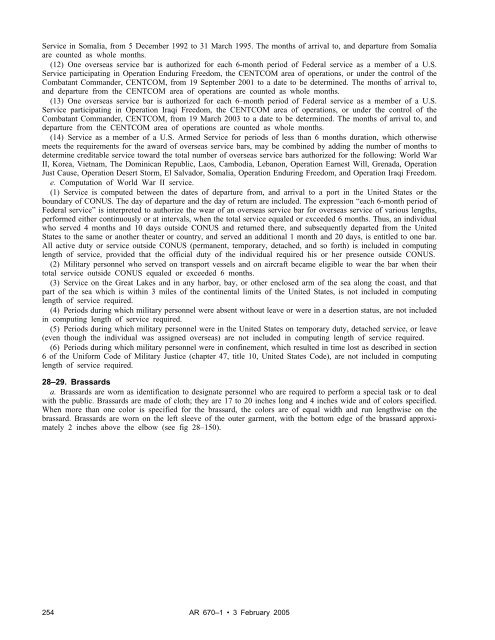Wear and Appearance of Army Uniforms and Insignia
Wear and Appearance of Army Uniforms and Insignia
Wear and Appearance of Army Uniforms and Insignia
Create successful ePaper yourself
Turn your PDF publications into a flip-book with our unique Google optimized e-Paper software.
Service in Somalia, from 5 December 1992 to 31 March 1995. The months <strong>of</strong> arrival to, <strong>and</strong> departure from Somalia<br />
are counted as whole months.<br />
(12) One overseas service bar is authorized for each 6-month period <strong>of</strong> Federal service as a member <strong>of</strong> a U.S.<br />
Service participating in Operation Enduring Freedom, the CENTCOM area <strong>of</strong> operations, or under the control <strong>of</strong> the<br />
Combatant Comm<strong>and</strong>er, CENTCOM, from 19 September 2001 to a date to be determined. The months <strong>of</strong> arrival to,<br />
<strong>and</strong> departure from the CENTCOM area <strong>of</strong> operations are counted as whole months.<br />
(13) One overseas service bar is authorized for each 6–month period <strong>of</strong> Federal service as a member <strong>of</strong> a U.S.<br />
Service participating in Operation Iraqi Freedom, the CENTCOM area <strong>of</strong> operations, or under the control <strong>of</strong> the<br />
Combatant Comm<strong>and</strong>er, CENTCOM, from 19 March 2003 to a date to be determined. The months <strong>of</strong> arrival to, <strong>and</strong><br />
departure from the CENTCOM area <strong>of</strong> operations are counted as whole months.<br />
(14) Service as a member <strong>of</strong> a U.S. Armed Service for periods <strong>of</strong> less than 6 months duration, which otherwise<br />
meets the requirements for the award <strong>of</strong> overseas service bars, may be combined by adding the number <strong>of</strong> months to<br />
determine creditable service toward the total number <strong>of</strong> overseas service bars authorized for the following: World War<br />
II, Korea, Vietnam, The Dominican Republic, Laos, Cambodia, Lebanon, Operation Earnest Will, Grenada, Operation<br />
Just Cause, Operation Desert Storm, El Salvador, Somalia, Operation Enduring Freedom, <strong>and</strong> Operation Iraqi Freedom.<br />
e. Computation <strong>of</strong> World War II service.<br />
(1) Service is computed between the dates <strong>of</strong> departure from, <strong>and</strong> arrival to a port in the United States or the<br />
boundary <strong>of</strong> CONUS. The day <strong>of</strong> departure <strong>and</strong> the day <strong>of</strong> return are included. The expression “each 6-month period <strong>of</strong><br />
Federal service” is interpreted to authorize the wear <strong>of</strong> an overseas service bar for overseas service <strong>of</strong> various lengths,<br />
performed either continuously or at intervals, when the total service equaled or exceeded 6 months. Thus, an individual<br />
who served 4 months <strong>and</strong> 10 days outside CONUS <strong>and</strong> returned there, <strong>and</strong> subsequently departed from the United<br />
States to the same or another theater or country, <strong>and</strong> served an additional 1 month <strong>and</strong> 20 days, is entitled to one bar.<br />
All active duty or service outside CONUS (permanent, temporary, detached, <strong>and</strong> so forth) is included in computing<br />
length <strong>of</strong> service, provided that the <strong>of</strong>ficial duty <strong>of</strong> the individual required his or her presence outside CONUS.<br />
(2) Military personnel who served on transport vessels <strong>and</strong> on aircraft became eligible to wear the bar when their<br />
total service outside CONUS equaled or exceeded 6 months.<br />
(3) Service on the Great Lakes <strong>and</strong> in any harbor, bay, or other enclosed arm <strong>of</strong> the sea along the coast, <strong>and</strong> that<br />
part <strong>of</strong> the sea which is within 3 miles <strong>of</strong> the continental limits <strong>of</strong> the United States, is not included in computing<br />
length <strong>of</strong> service required.<br />
(4) Periods during which military personnel were absent without leave or were in a desertion status, are not included<br />
in computing length <strong>of</strong> service required.<br />
(5) Periods during which military personnel were in the United States on temporary duty, detached service, or leave<br />
(even though the individual was assigned overseas) are not included in computing length <strong>of</strong> service required.<br />
(6) Periods during which military personnel were in confinement, which resulted in time lost as described in section<br />
6 <strong>of</strong> the Uniform Code <strong>of</strong> Military Justice (chapter 47, title 10, United States Code), are not included in computing<br />
length <strong>of</strong> service required.<br />
28–29. Brassards<br />
a. Brassards are worn as identification to designate personnel who are required to perform a special task or to deal<br />
with the public. Brassards are made <strong>of</strong> cloth; they are 17 to 20 inches long <strong>and</strong> 4 inches wide <strong>and</strong> <strong>of</strong> colors specified.<br />
When more than one color is specified for the brassard, the colors are <strong>of</strong> equal width <strong>and</strong> run lengthwise on the<br />
brassard. Brassards are worn on the left sleeve <strong>of</strong> the outer garment, with the bottom edge <strong>of</strong> the brassard approximately<br />
2 inches above the elbow (see fig 28–150).<br />
254 AR 670–1 3 February 2005

















